FORD F750 2015 13.G Owners Manual
Manufacturer: FORD, Model Year: 2015, Model line: F750, Model: FORD F750 2015 13.GPages: 384, PDF Size: 4.95 MB
Page 91 of 384
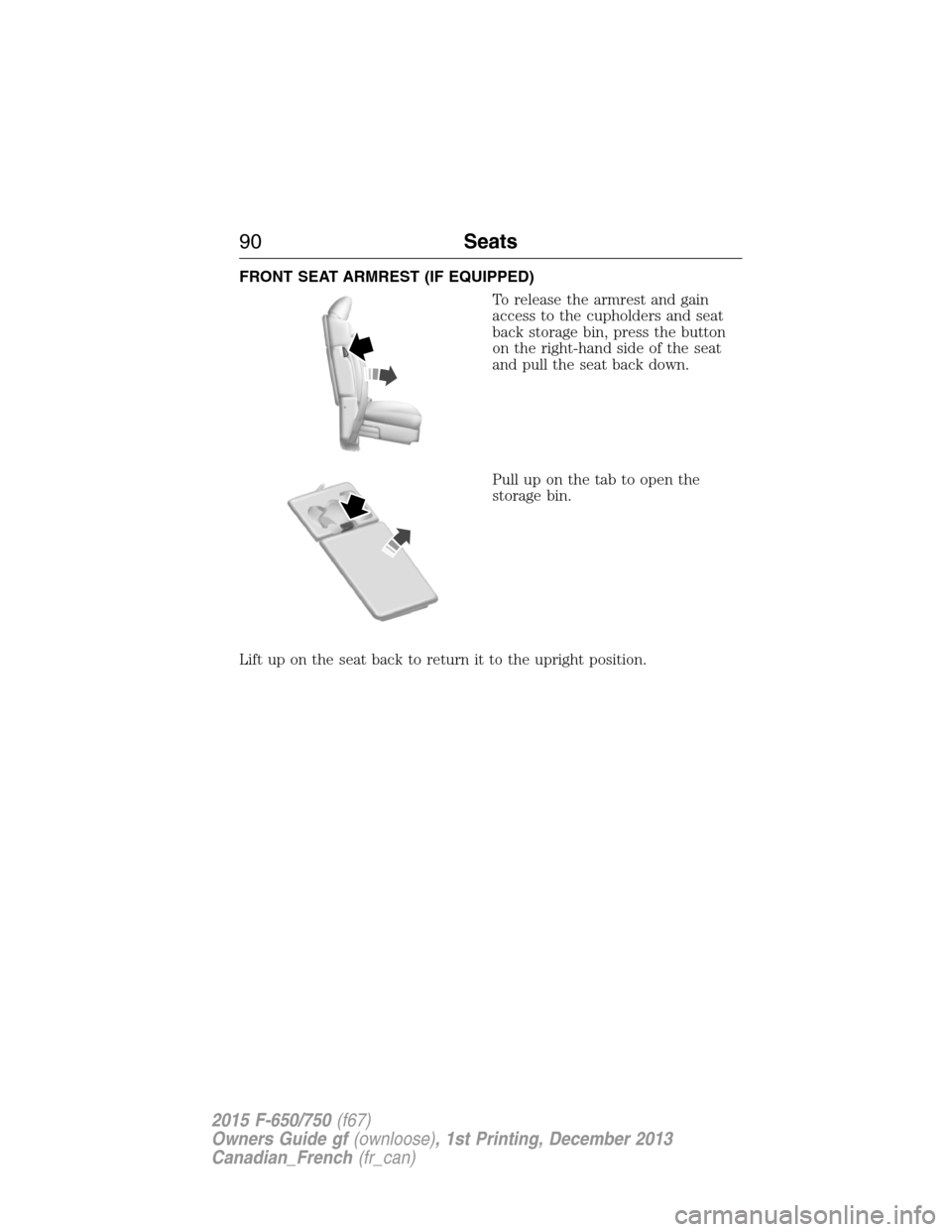
FRONT SEAT ARMREST (IF EQUIPPED)
To release the armrest and gain
access to the cupholders and seat
back storage bin, press the button
on the right-hand side of the seat
and pull the seat back down.
Pull up on the tab to open the
storage bin.
Lift up on the seat back to return it to the upright position.
90Seats
2015 F-650/750(f67)
Owners Guide gf(ownloose), 1st Printing, December 2013
Canadian_French(fr_can)
Page 92 of 384

AUXILIARY POWER POINTS
WARNING:Do not plug optional electrical accessories into the
cigarette lighter socket (if equipped). Improper use of the lighter
can cause damage not covered by your warranty, and can result in fire
or serious injury.
Note:If you use the power points when the engine is not running, the
battery may discharge and there may not be sufficient battery power to
start your engine.
Note:Do not insert objects other than an accessory plug into the power
point. This damages the outlet and blows the fuse.
Note:Do not hang any type of accessory or accessory bracket from the
plug.
Note:Do not use the power point over the vehicle capacity of 12–volt
DC 180 watts or a fuse may blow.
Note:Do not use the power point for operating a cigarette lighter
element.
Note:Improper use of the power point can cause damage not covered
by your warranty.
Note:Always keep the power point caps closed when they are not in
use.
Run the engine for full capacity use of the power point. To prevent the
battery from discharging:
•Do not use the power point longer than necessary when the engine is
not running.
•Do not leave devices plugged in overnight or when you park your
vehicle for extended periods.
Locations
Power points may be:
•On the instrument panel (two locations).
•Inside the center console storage compartment (if equipped).
•On the rear of the center console (if equipped).
•Inside the 20-percent front seat console (if equipped).
•Inside the rear under seat storage compartment (if equipped).
Auxiliary Power Points91
2015 F-650/750(f67)
Owners Guide gf(ownloose), 1st Printing, December 2013
Canadian_French(fr_can)
Page 93 of 384
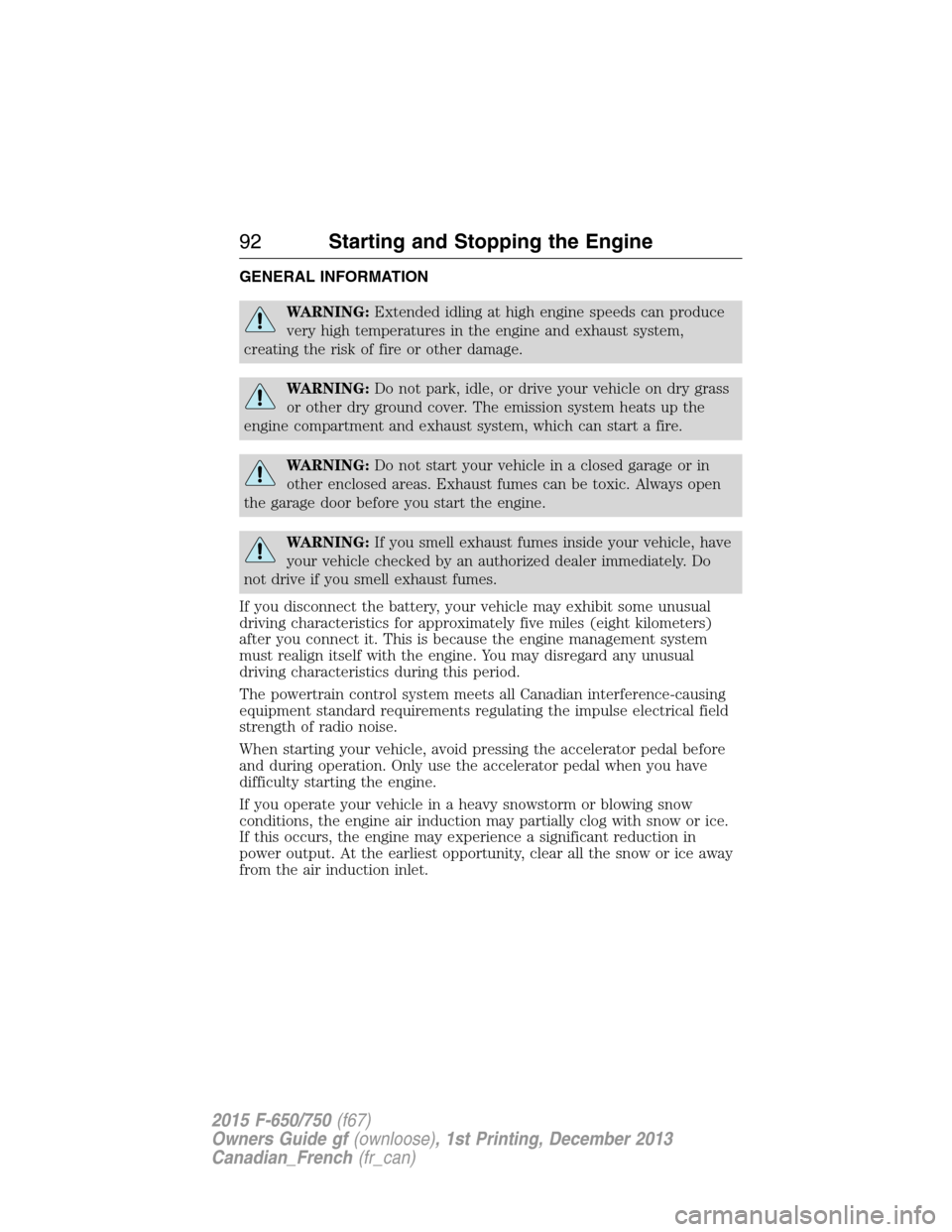
GENERAL INFORMATION
WARNING:Extended idling at high engine speeds can produce
very high temperatures in the engine and exhaust system,
creating the risk of fire or other damage.
WARNING:Do not park, idle, or drive your vehicle on dry grass
or other dry ground cover. The emission system heats up the
engine compartment and exhaust system, which can start a fire.
WARNING:Do not start your vehicle in a closed garage or in
other enclosed areas. Exhaust fumes can be toxic. Always open
the garage door before you start the engine.
WARNING:If you smell exhaust fumes inside your vehicle, have
your vehicle checked by an authorized dealer immediately. Do
not drive if you smell exhaust fumes.
If you disconnect the battery, your vehicle may exhibit some unusual
driving characteristics for approximately five miles (eight kilometers)
after you connect it. This is because the engine management system
must realign itself with the engine. You may disregard any unusual
driving characteristics during this period.
The powertrain control system meets all Canadian interference-causing
equipment standard requirements regulating the impulse electrical field
strength of radio noise.
When starting your vehicle, avoid pressing the accelerator pedal before
and during operation. Only use the accelerator pedal when you have
difficulty starting the engine.
If you operate your vehicle in a heavy snowstorm or blowing snow
conditions, the engine air induction may partially clog with snow or ice.
If this occurs, the engine may experience a significant reduction in
power output. At the earliest opportunity, clear all the snow or ice away
from the air induction inlet.
92Starting and Stopping the Engine
2015 F-650/750(f67)
Owners Guide gf(ownloose), 1st Printing, December 2013
Canadian_French(fr_can)
Page 94 of 384
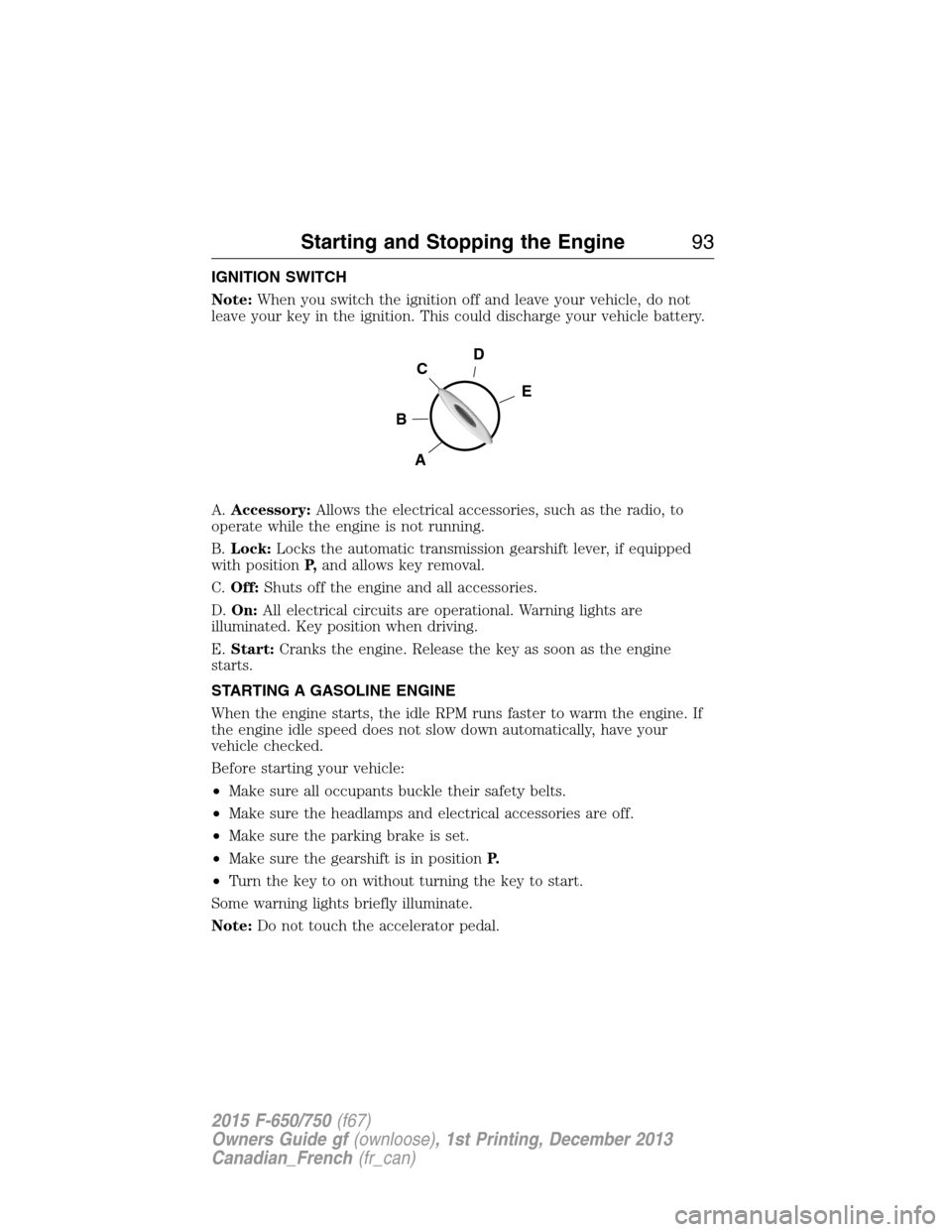
IGNITION SWITCH
Note:When you switch the ignition off and leave your vehicle, do not
leave your key in the ignition. This could discharge your vehicle battery.
A.Accessory:Allows the electrical accessories, such as the radio, to
operate while the engine is not running.
B.Lock:Locks the automatic transmission gearshift lever, if equipped
with positionP,and allows key removal.
C.Off:Shuts off the engine and all accessories.
D.On:All electrical circuits are operational. Warning lights are
illuminated. Key position when driving.
E.Start:Cranks the engine. Release the key as soon as the engine
starts.
STARTING A GASOLINE ENGINE
When the engine starts, the idle RPM runs faster to warm the engine. If
the engine idle speed does not slow down automatically, have your
vehicle checked.
Before starting your vehicle:
•Make sure all occupants buckle their safety belts.
•Make sure the headlamps and electrical accessories are off.
•Make sure the parking brake is set.
•Make sure the gearshift is in positionP.
•Turn the key to on without turning the key to start.
Some warning lights briefly illuminate.
Note:Do not touch the accelerator pedal.
D
E
C
B
A
Starting and Stopping the Engine93
2015 F-650/750(f67)
Owners Guide gf(ownloose), 1st Printing, December 2013
Canadian_French(fr_can)
Page 95 of 384
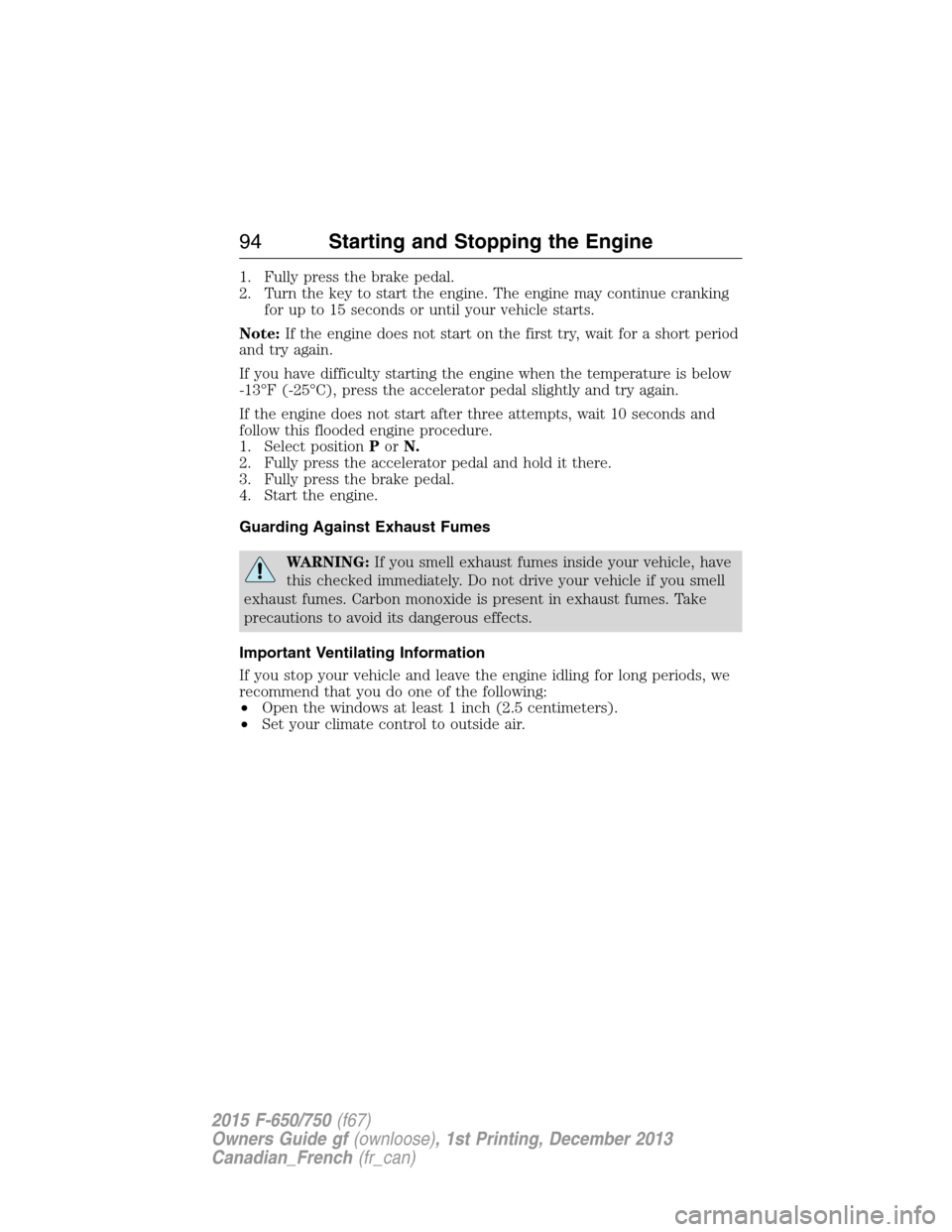
1. Fully press the brake pedal.
2. Turn the key to start the engine. The engine may continue cranking
for up to 15 seconds or until your vehicle starts.
Note:If the engine does not start on the first try, wait for a short period
and try again.
If you have difficulty starting the engine when the temperature is below
-13°F (-25°C), press the accelerator pedal slightly and try again.
If the engine does not start after three attempts, wait 10 seconds and
follow this flooded engine procedure.
1. Select positionPorN.
2. Fully press the accelerator pedal and hold it there.
3. Fully press the brake pedal.
4. Start the engine.
Guarding Against Exhaust Fumes
WARNING:If you smell exhaust fumes inside your vehicle, have
this checked immediately. Do not drive your vehicle if you smell
exhaust fumes. Carbon monoxide is present in exhaust fumes. Take
precautions to avoid its dangerous effects.
Important Ventilating Information
If you stop your vehicle and leave the engine idling for long periods, we
recommend that you do one of the following:
•Open the windows at least 1 inch (2.5 centimeters).
•Set your climate control to outside air.
94Starting and Stopping the Engine
2015 F-650/750(f67)
Owners Guide gf(ownloose), 1st Printing, December 2013
Canadian_French(fr_can)
Page 96 of 384
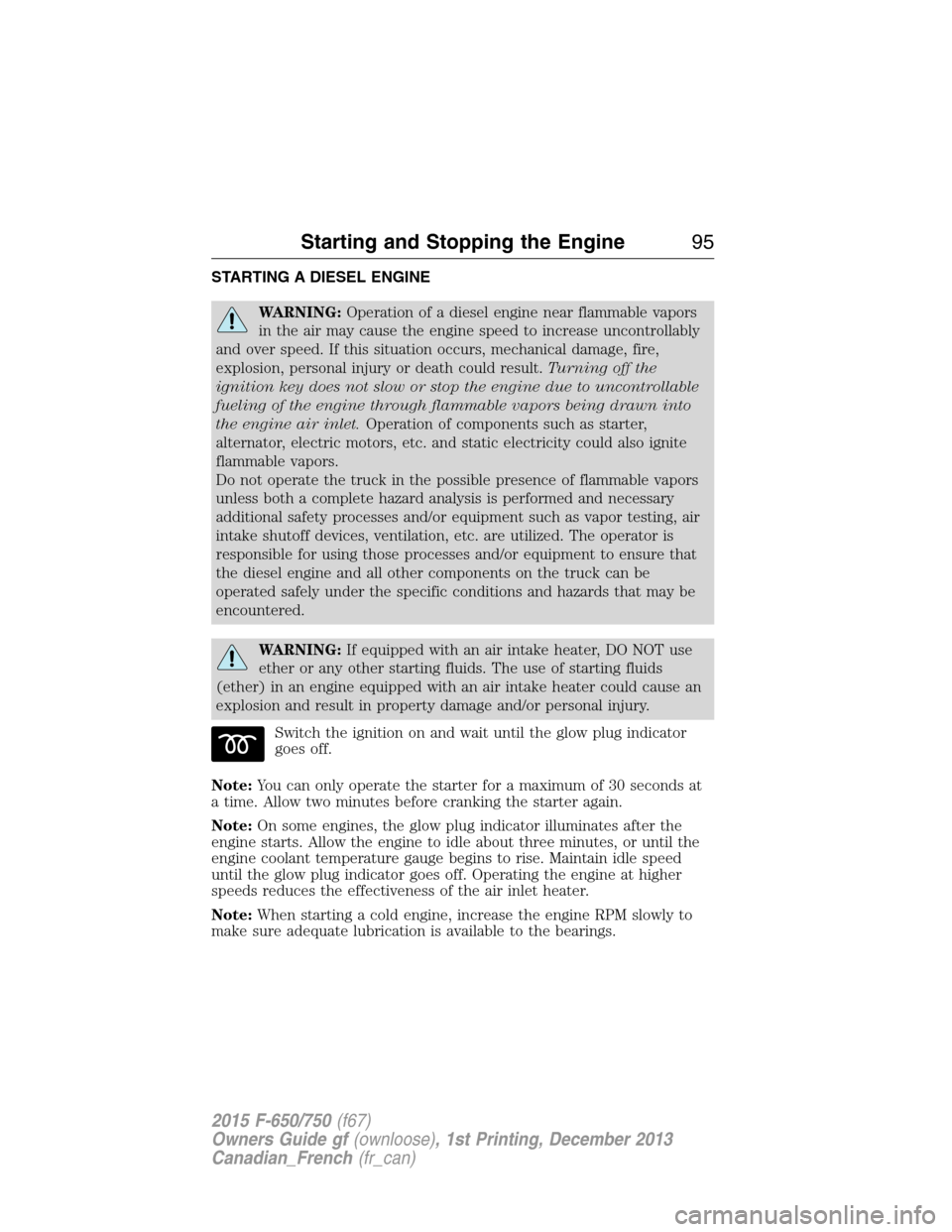
STARTING A DIESEL ENGINE
WARNING:Operation of a diesel engine near flammable vapors
in the air may cause the engine speed to increase uncontrollably
and over speed. If this situation occurs, mechanical damage, fire,
explosion, personal injury or death could result.Turning off the
ignition key does not slow or stop the engine due to uncontrollable
fueling of the engine through flammable vapors being drawn into
the engine air inlet.Operation of components such as starter,
alternator, electric motors, etc. and static electricity could also ignite
flammable vapors.
Do not operate the truck in the possible presence of flammable vapors
unless both a complete hazard analysis is performed and necessary
additional safety processes and/or equipment such as vapor testing, air
intake shutoff devices, ventilation, etc. are utilized. The operator is
responsible for using those processes and/or equipment to ensure that
the diesel engine and all other components on the truck can be
operated safely under the specific conditions and hazards that may be
encountered.
WARNING:If equipped with an air intake heater, DO NOT use
ether or any other starting fluids. The use of starting fluids
(ether) in an engine equipped with an air intake heater could cause an
explosion and result in property damage and/or personal injury.
Switch the ignition on and wait until the glow plug indicator
goes off.
Note:You can only operate the starter for a maximum of 30 seconds at
a time. Allow two minutes before cranking the starter again.
Note:On some engines, the glow plug indicator illuminates after the
engine starts. Allow the engine to idle about three minutes, or until the
engine coolant temperature gauge begins to rise. Maintain idle speed
until the glow plug indicator goes off. Operating the engine at higher
speeds reduces the effectiveness of the air inlet heater.
Note:When starting a cold engine, increase the engine RPM slowly to
make sure adequate lubrication is available to the bearings.
Starting and Stopping the Engine95
2015 F-650/750(f67)
Owners Guide gf(ownloose), 1st Printing, December 2013
Canadian_French(fr_can)
Page 97 of 384
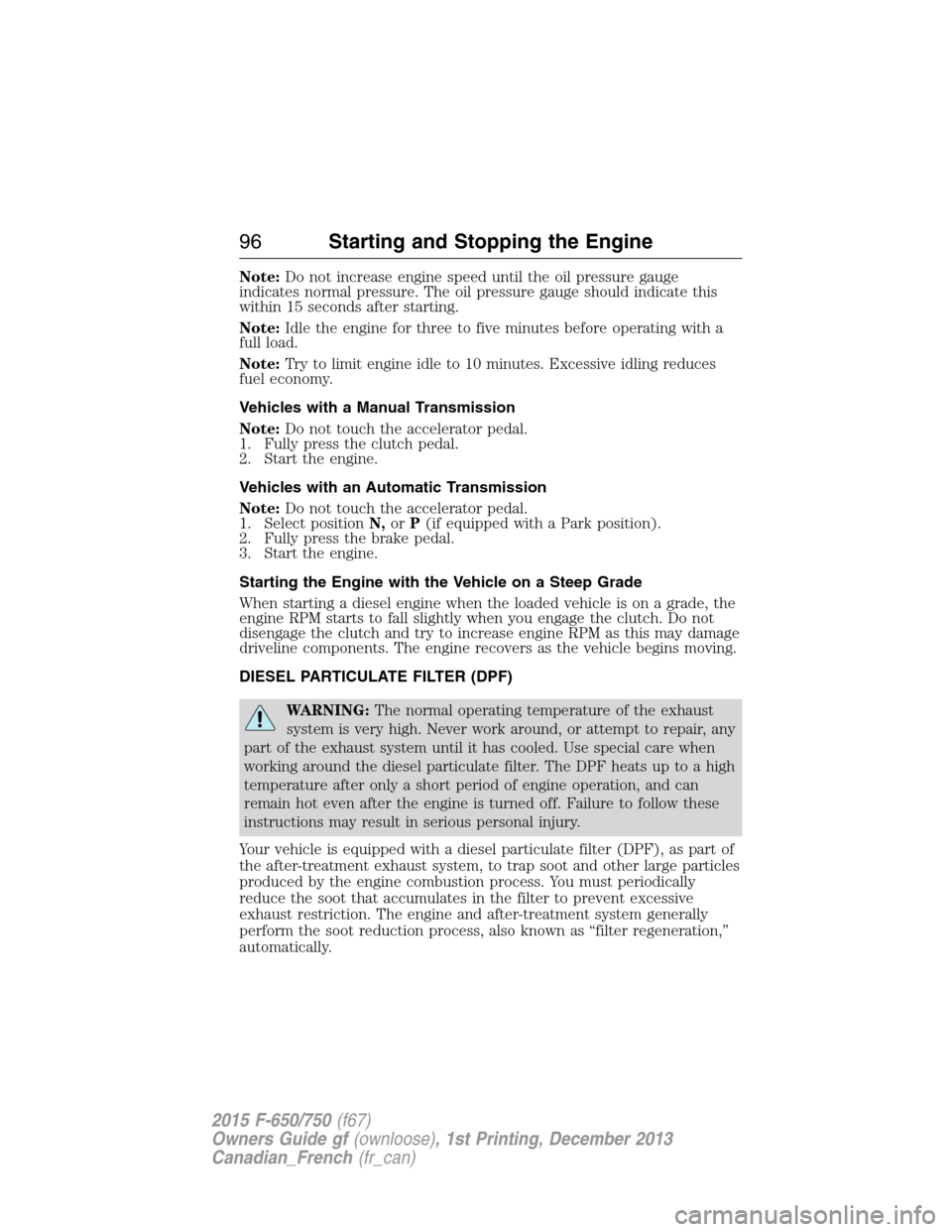
Note:Do not increase engine speed until the oil pressure gauge
indicates normal pressure. The oil pressure gauge should indicate this
within 15 seconds after starting.
Note:Idle the engine for three to five minutes before operating with a
full load.
Note:Try to limit engine idle to 10 minutes. Excessive idling reduces
fuel economy.
Vehicles with a Manual Transmission
Note:Do not touch the accelerator pedal.
1. Fully press the clutch pedal.
2. Start the engine.
Vehicles with an Automatic Transmission
Note:Do not touch the accelerator pedal.
1. Select positionN,orP(if equipped with a Park position).
2. Fully press the brake pedal.
3. Start the engine.
Starting the Engine with the Vehicle on a Steep Grade
When starting a diesel engine when the loaded vehicle is on a grade, the
engine RPM starts to fall slightly when you engage the clutch. Do not
disengage the clutch and try to increase engine RPM as this may damage
driveline components. The engine recovers as the vehicle begins moving.
DIESEL PARTICULATE FILTER (DPF)
WARNING:The normal operating temperature of the exhaust
system is very high. Never work around, or attempt to repair, any
part of the exhaust system until it has cooled. Use special care when
working around the diesel particulate filter. The DPF heats up to a high
temperature after only a short period of engine operation, and can
remain hot even after the engine is turned off. Failure to follow these
instructions may result in serious personal injury.
Your vehicle is equipped with a diesel particulate filter (DPF), as part of
the after-treatment exhaust system, to trap soot and other large particles
produced by the engine combustion process. You must periodically
reduce the soot that accumulates in the filter to prevent excessive
exhaust restriction. The engine and after-treatment system generally
perform the soot reduction process, also known as “filter regeneration,”
automatically.
96Starting and Stopping the Engine
2015 F-650/750(f67)
Owners Guide gf(ownloose), 1st Printing, December 2013
Canadian_French(fr_can)
Page 98 of 384
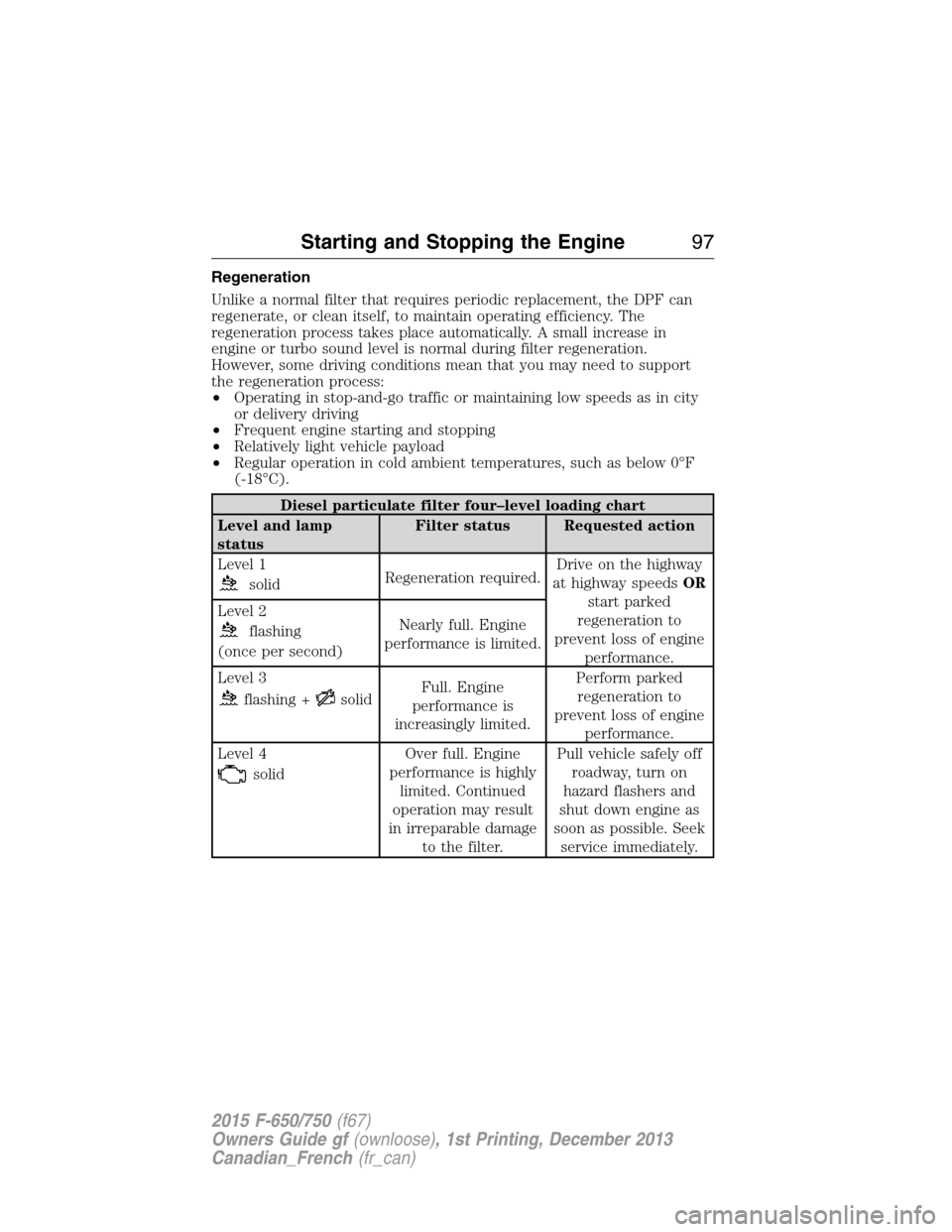
Regeneration
Unlike a normal filter that requires periodic replacement, the DPF can
regenerate, or clean itself, to maintain operating efficiency. The
regeneration process takes place automatically. A small increase in
engine or turbo sound level is normal during filter regeneration.
However, some driving conditions mean that you may need to support
the regeneration process:
•Operating in stop-and-go traffic or maintaining low speeds as in city
or delivery driving
•Frequent engine starting and stopping
•Relatively light vehicle payload
•Regular operation in cold ambient temperatures, such as below 0°F
(-18°C).
Diesel particulate filter four–level loading chart
Level and lamp
statusFilter status Requested action
Level 1
solidRegeneration required.Drive on the highway
at highway speedsOR
start parked
regeneration to
prevent loss of engine
performance. Level 2
flashing
(once per second)Nearly full. Engine
performance is limited.
Level 3
flashing +solidFull. Engine
performance is
increasingly limited.Perform parked
regeneration to
prevent loss of engine
performance.
Level 4
solidOver full. Engine
performance is highly
limited. Continued
operation may result
in irreparable damage
to the filter.Pull vehicle safely off
roadway, turn on
hazard flashers and
shut down engine as
soon as possible. Seek
service immediately.
Starting and Stopping the Engine97
2015 F-650/750(f67)
Owners Guide gf(ownloose), 1st Printing, December 2013
Canadian_French(fr_can)
Page 99 of 384
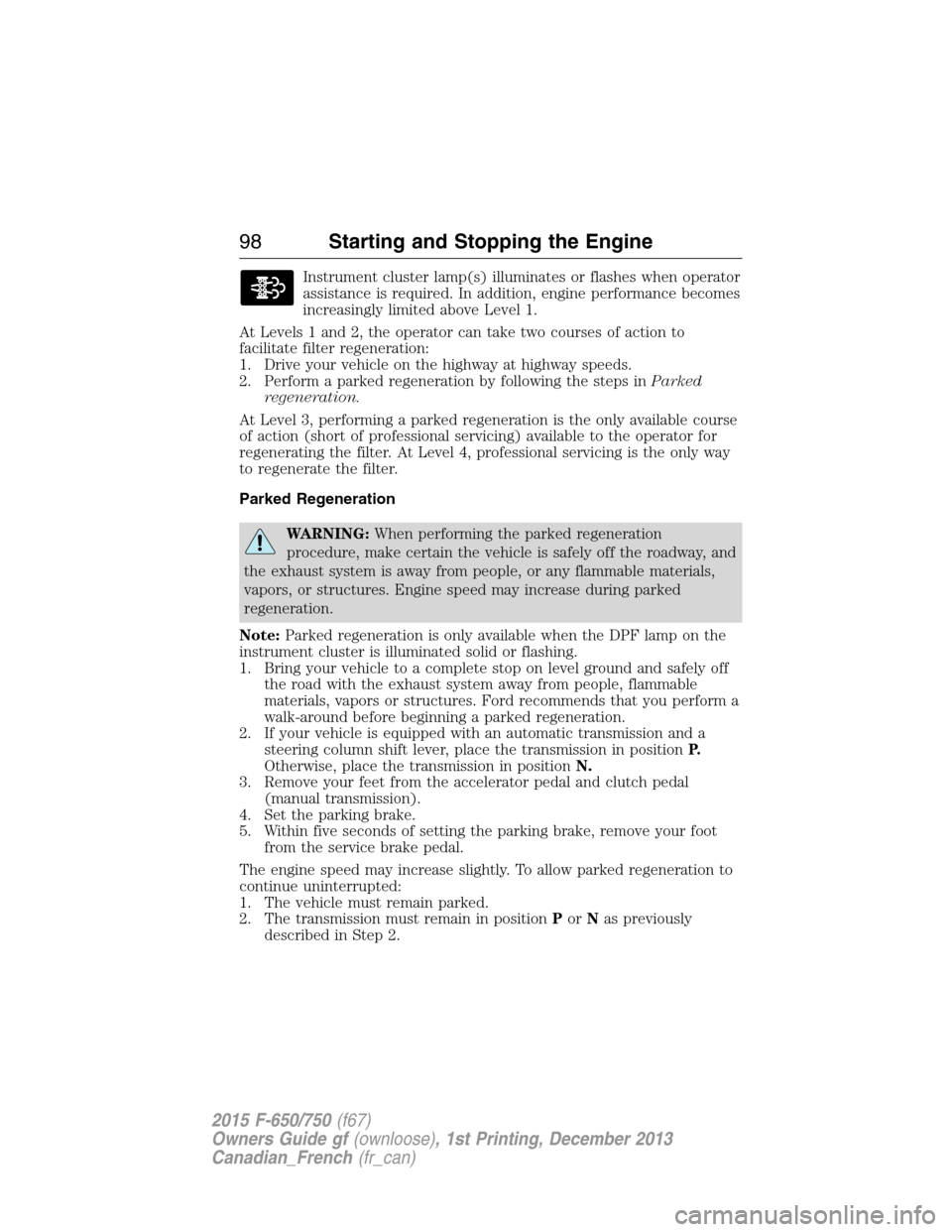
Instrument cluster lamp(s) illuminates or flashes when operator
assistance is required. In addition, engine performance becomes
increasingly limited above Level 1.
At Levels 1 and 2, the operator can take two courses of action to
facilitate filter regeneration:
1. Drive your vehicle on the highway at highway speeds.
2. Perform a parked regeneration by following the steps inParked
regeneration.
At Level 3, performing a parked regeneration is the only available course
of action (short of professional servicing) available to the operator for
regenerating the filter. At Level 4, professional servicing is the only way
to regenerate the filter.
Parked Regeneration
WARNING:When performing the parked regeneration
procedure, make certain the vehicle is safely off the roadway, and
the exhaust system is away from people, or any flammable materials,
vapors, or structures. Engine speed may increase during parked
regeneration.
Note:Parked regeneration is only available when the DPF lamp on the
instrument cluster is illuminated solid or flashing.
1. Bring your vehicle to a complete stop on level ground and safely off
the road with the exhaust system away from people, flammable
materials, vapors or structures. Ford recommends that you perform a
walk-around before beginning a parked regeneration.
2. If your vehicle is equipped with an automatic transmission and a
steering column shift lever, place the transmission in positionP.
Otherwise, place the transmission in positionN.
3. Remove your feet from the accelerator pedal and clutch pedal
(manual transmission).
4. Set the parking brake.
5. Within five seconds of setting the parking brake, remove your foot
from the service brake pedal.
The engine speed may increase slightly. To allow parked regeneration to
continue uninterrupted:
1. The vehicle must remain parked.
2. The transmission must remain in positionPorNas previously
described in Step 2.
98Starting and Stopping the Engine
2015 F-650/750(f67)
Owners Guide gf(ownloose), 1st Printing, December 2013
Canadian_French(fr_can)
Page 100 of 384
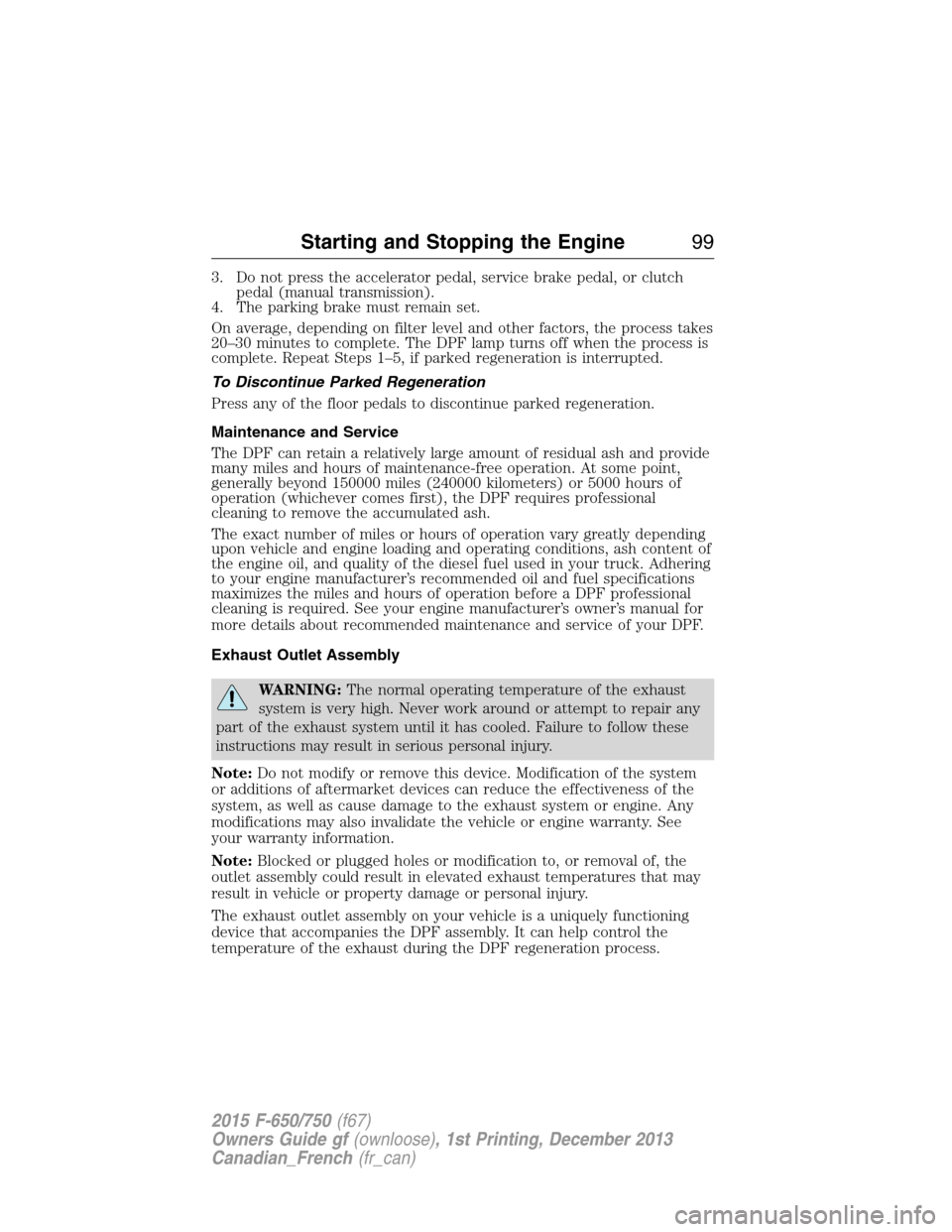
3. Do not press the accelerator pedal, service brake pedal, or clutch
pedal (manual transmission).
4. The parking brake must remain set.
On average, depending on filter level and other factors, the process takes
20–30 minutes to complete. The DPF lamp turns off when the process is
complete. Repeat Steps 1–5, if parked regeneration is interrupted.
To Discontinue Parked Regeneration
Press any of the floor pedals to discontinue parked regeneration.
Maintenance and Service
The DPF can retain a relatively large amount of residual ash and provide
many miles and hours of maintenance-free operation. At some point,
generally beyond 150000 miles (240000 kilometers) or 5000 hours of
operation (whichever comes first), the DPF requires professional
cleaning to remove the accumulated ash.
The exact number of miles or hours of operation vary greatly depending
upon vehicle and engine loading and operating conditions, ash content of
the engine oil, and quality of the diesel fuel used in your truck. Adhering
to your engine manufacturer’s recommended oil and fuel specifications
maximizes the miles and hours of operation before a DPF professional
cleaning is required. See your engine manufacturer’s owner’s manual for
more details about recommended maintenance and service of your DPF.
Exhaust Outlet Assembly
WARNING:The normal operating temperature of the exhaust
system is very high. Never work around or attempt to repair any
part of the exhaust system until it has cooled. Failure to follow these
instructions may result in serious personal injury.
Note:Do not modify or remove this device. Modification of the system
or additions of aftermarket devices can reduce the effectiveness of the
system, as well as cause damage to the exhaust system or engine. Any
modifications may also invalidate the vehicle or engine warranty. See
your warranty information.
Note:Blocked or plugged holes or modification to, or removal of, the
outlet assembly could result in elevated exhaust temperatures that may
result in vehicle or property damage or personal injury.
The exhaust outlet assembly on your vehicle is a uniquely functioning
device that accompanies the DPF assembly. It can help control the
temperature of the exhaust during the DPF regeneration process.
Starting and Stopping the Engine99
2015 F-650/750(f67)
Owners Guide gf(ownloose), 1st Printing, December 2013
Canadian_French(fr_can)